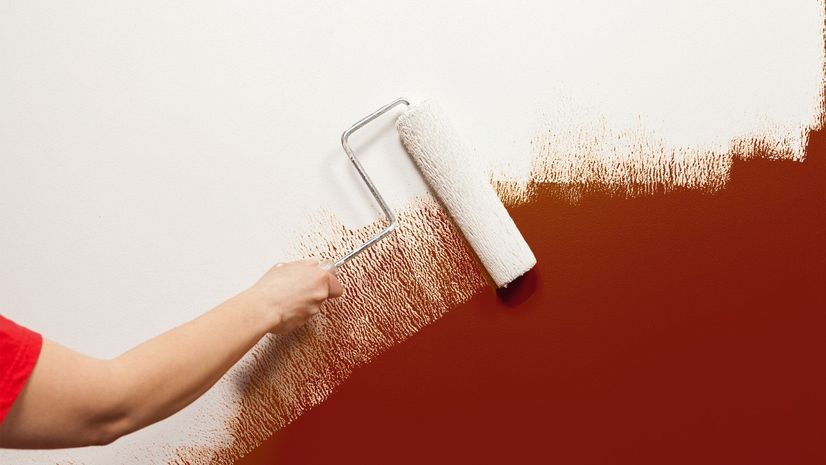
Imagine this: You’ve been house hunting for months and finally found the place of your fantasies. It’s the perfect size, in great condition, and within your budget—it’s everything you’ve ever wanted.
The only problem? All of the walls are covered in deep blues, rich reds, and—dare we say—grim but oh-so-trendy black. Before you know it, you then find yourself Googling, “How to cover dark paint with light paint?”
How to paint over dark walls: What to know about painting over dark colors
Before you pick up the phone to call a pro, know this: You can transform your walls yourself. But it’ll take knowing a few tricks of the trade, owning the right tools, finding the best primer to cover dark walls and dark paint, and having loads of patience. Luckily, we talked with the pros to give you a primer (yep, we went there) on painting over dark colors so that you can lighten up already.
1. Start with the right supplies
To save on time and sanity, you’re going to need more than an old roller and a paintbrush. An investment in the right supplies will make for a (literally!) smoother process throughout.
Start by selecting a roller with the right nap, or thickness, for your project. The rougher the surface, the thicker your roller should be—thicker naps are designed to hold more paint in order to fill the crevices of bumpy surfaces. If your walls are dark but smooth, opt for a thinner nap or a foam roller. It’ll give smooth coverage (and is usually ideal for indoor walls).
Next, choose high-quality rollers. Higher-end products tend to deliver smoother, thicker paint coats than their cheaper counterparts, which can have spottier coverage.
Finally, look for the best primer to cover dark paint and the best paint to cover dark walls. Alex Kolsum of Eric Kolsum Painting in Minneapolis, MN, recommends acrylic-based paint.
“These days it works just as well as oil-based paint, and it’s safer for the environment,” he says.
2. Prep the surface
Not feeling the chalkboard paint craze? Covering it up will take a bit of finesse. To paint over a writable surface—or any thickly applied coating—be sure to sand the edges until they’re smooth. Otherwise you’ll be able to see the lines underneath no matter how many coats you slather on.
You’ll also want to clean the walls—the cleaner they are, the smoother the paint job. Next, run painter’s tape along the edges between the wall and ceiling/baseboards, making sure the corners are fully covered. And, of course, lay dropcloths on the floor. (You knew about that part, right?)
3. Pick the best primer to cover dark paint
Hit up the paint supply store these days, and you’ll notice that primers come in a variety of hues. Intuition might tell you to opt for a gray (darker) primer to cover a darker color, but you should resist the urge. Choose white primer when going from dark to light, experts say, and gray when going from light to dark.
Krista Zobel, an interior designer at TreHus in Minneapolis, offers up this special trick: Mix a little paint with the primer. Adding some of your new paint color to the first coat can help to set the right tone from the get-go.
And make sure you don’t cheap out, Zobel adds. Quality primers contain more binders and pigments, which is what will help conceal the dark color underneath.
4. Use multiple coats of the best primer to cover dark paint
Usually, you can get away with one coat of primer. But when it comes to painting over a dark color with a lighter one, two coats of primer(literally) put an extra layer between the colors and reduce the chances that the dark color will bleed through.
(Fun fact: Red is usually the most difficult shade to cover up. “Something with a red pigment seems to kind of pierce through the opacity of paint more than black,” Zobel says.)
Finally, don’t forget to let the primer dry completely before you start painting.
5. Lay it on thick
One common mistake DIY painters make when painting over dark colors? Spreading the paint too thin, Kolsum says.
“Always add more paint than you think,” he says. “You want heavy coverage when you’re rolling.”
Then, when you’re painting, roll in big “M” or “W” shapes rather than just up and down. This approach gives the paint a few seconds to dry rather than immediately covering it up again.
And remember: The more extreme your dark-to-light transformation, the more layers you’ll need to get the job done—and the longer the project will take. One wall will take one person about a half-day to complete, Kolsum estimates.
“Just keep putting layers on until the [dark color] is gone,” he says.
6. Take a break
One of the best parts of painting over dark colors is the built-in break time. You’ve got to let the paint dry between layers, so sit back, relax, and enjoy a good book or take the dog for a walk between coats.
How long should you wait? Acrylic paint dries quickly—about 15 or 30 minutes depending on temperature and humidity, Kolsum says.
7. If all else fails, innovate
Does lightening up those dark walls sound like more than you bargained for? Don’t worry—it’s just time to get creative. Consider painting over dark colors with another dark color you actually like. Or opt for coverage that doesn’t include paint at all.
“Wallpaper is making a big comeback,” Zobel says. “It’s not as permanent as it used to be.”
Indeed, there are tons of gorgeous removable wallpaper options if you want a new look but are afraid to commit. Slap some on, and let your dark walls be the next homeowner’s problem.
Article originally appeared on Realtor.com.







